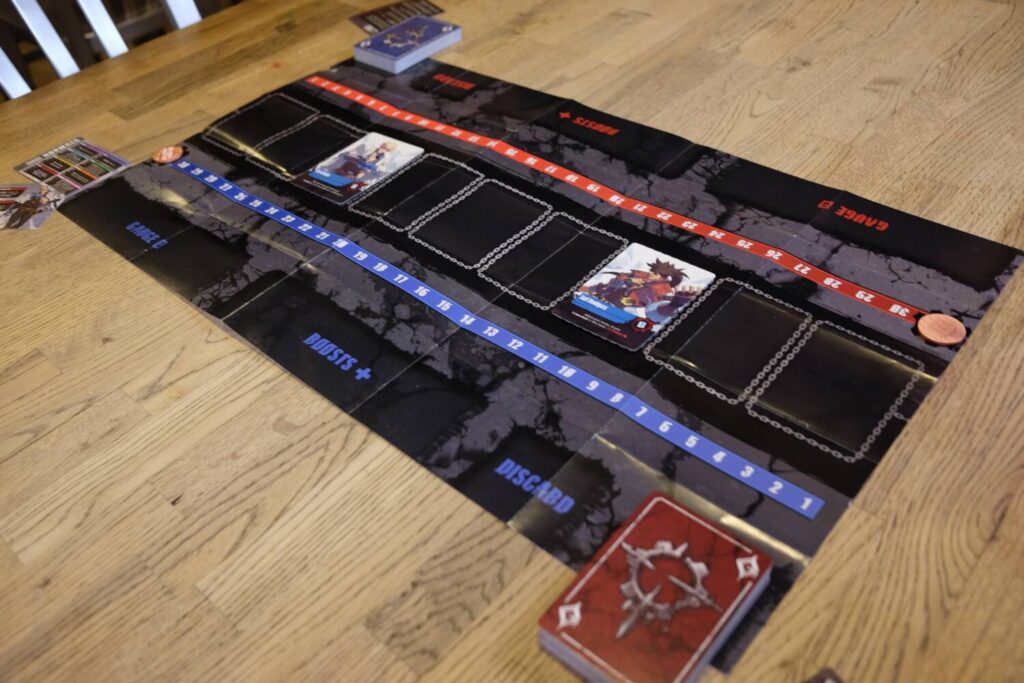Guilty Gear is widely considered one of the great 2D fighting franchises in video game history. Though the series has never achieved the cultural prominence of Street Fighter or Tekken, it has long been lauded for its technically exacting gameplay and visual flair. Earlier this year, Level 99 Games announced that they were adapting Guilty Gear: Strive, the most recent title, into a two-person card game.
It’s a sensible marriage. Much as Guilty Gear has been a long-running cult success, Level 99’s Exceed Fighting System has been a niche favorite, beloved by a certain type of board game enthusiast, for most of the last decade. The system has adapted video games before, with entries for Shovel Knight and Dead Cells, but never with this level of ambition. A stonking 20 characters will be included in the final version of Guilty Gear: Strive.
That won’t be available for a while yet, but I spent some time with the demo deck, which includes Sol Badguy (incredible name) and Ky Kiske. The choice of these two characters for the demo should provide longtime Guilty Gear fans with assurance that they’re in good hands. Sol and Ky are the only two characters to have appeared in every installment of the series.

Duel 1
The first step, of course, is to pick a character. Each has their own self-contained deck. There’s no prep involved besides picking up the desired deck, putting your character card out on the combat board, placing your life counter at 30, and shuffling up.
You take turns performing a single action. You can move, draw cards, reshuffle your deck, play a card for its special effect (the game refers to this as a Boost effect), or attack your opponent (Strike). The design is pretty clean as far as these things go, and for that I commend it.
The two parts of the system that I want to highlight are reshuffling and Striking, since I think the former is a great little source of tension and the latter is arguably why we’re here.

Reshuffling can be manual, done as an action, or automatic, which happens when you run out of deck. You can choose to reshuffle at any point, but you can only do it once. If your deck runs out after you reshuffle, you lose the game. I like this, because you have the ability to call back a great card at any point, but you do so with the risk that your opponent might survive it and outlast you. It also introduces timing considerations around refilling your deck when your opponent is running low on cards. That suggests, with increased familiarity with each character, a remarkably high skill ceiling.
When a player declares a Strike, they set either one or two matching cards face-down on the table. The defender does the same, then both players reveal what they’ve played. Each card has a variety of stats on the left-hand side that come into effect at this point. Speed determines which player’s attack triggers first. Range tells you how far you have to be from your opponent for the attack to hit. Power is how much damage the attack does if it hits, while Armor will reduce damage taken and Guard decides whether or not the attacked player is stunned, which prevents them from counter-attacking.
Like many dueling games, the big draw of the Exceed system is asymmetry. Every character handles differently. Some like to stay close, while others prefer to keep their distance. Some specialize in biding their time to build up a stronger single attack, while others prefer to rain down a quick and unrelenting series of blows.
My only complaint here is related to the card design. The stats apply in a very particular order, as I just articulated. Speed, then Range, then Power, then Armor, then Guard. They’re not in that order on the cards, and it definitely slows down combat early on. Having Range at the top does make sense, since that’s the number you need to know to have any sense of whether or not your attack will be effective, but I don’t agree with the choice.

Duel 2
There are two ways to play a fighting video game. Most of us fall into the first camp, where we maybe know a couple of fancy moves, some of the combos, but ultimately we’re smashing buttons. Then there are the professionals. If you’ve never watched a high-level fighting match, I recommend it. The players who dedicate their lives to Street Fighter and Virtua Fighter 4 are capable of some remarkable things. You can see the difference. The whole game feels different. Their moves are intentional, subtly timed, and restrained.
What most impresses me about Guilty Gear: Strive is the way it captures the feel of how professionals play fighting games. You can lash out randomly every turn, but it’s not going to work very well. It’s better to bide your time, find your stance, and choose your moments. If your opponent is lining up a big hit, get ready to press the guard button before responding with a quick and nasty counter. In a race to 0 health, a hit’s a hit.
Something I don’t normally get to say about games I review: if you want to try Guilty Gear: Strive before you pay for it (she’s expensive), you yourself can order a demo deck for free from the Level 99 website. This is not a game that’ll be for everyone, but the people who love it, will love it. Let’s rock.











Back in the day, I played a lot of Magic: the Gathering. Over the years, I made note of many complaints about the design — one of which was that aggressive (agro) play is almost always rewarded, where slower, methodical play is not. I played a lot of blue in my early days, and blue had a lot of tricks up its sleeve. On the surface, blue looks like it was designed for slower, methodical play. Slow down your opponent with counter-spells and such, take over the things they have on the board, change the reality of their cards, this sort of thing.
If you look at the Power 9, almost half of them are in the realm of blue (Ancestral Recall, Mox Sapphire, Time Twister, and Time Walk). Look at these cards though — none of them are slow, methodical cards. They are very aggressive cards — none more so that Mox Sapphire and Ancestral Recall). The idea that a deck can play a cat-and-mouse game of slowly building up to that one big play is just not something at which the game was very good. Perhaps things have changed since I stopped playing, but somehow I doubt it.
Other games suffered from the same problem. Dominion is a game where you could work toward some great combo plays… or just be aggressive, gather coins, then gather the big point cards. Guess which one wins out more often than not? Granted, some of the very late expansions for that game created a much more interesting set of possibilities. But agro still seems the way to go.
In this wonderful review, you state that the game plays like professional players of the video game. I quote: “You can lash out randomly every turn, but it’s not going to work very well. It’s better to bide your time, find your stance, and choose your moments. If your opponent is lining up a big hit, get ready to press the guard button before responding with a quick and nasty counter. In a race to 0 health, a hit’s a hit.”
If this is the case… if this is a game that has finally figured out how to allow a player to work the game in such a way as to slow the agro player’s effectiveness, while biding time and building up for that one big hit (and actually be able to make that hit effective), then you have my undivided attention.
I am not a fan of the video game (modern fighting games were never my thing). I am a fan of this type of card game, however. If it can deliver, then this might be something I want to delve into! I am already a fan of Level99; they have two wonderful games that I have very high regard for (Empyreal and Argent). So this might be a great fit for me and my gaming group.
Thanks for a great review! You guys are amazing.